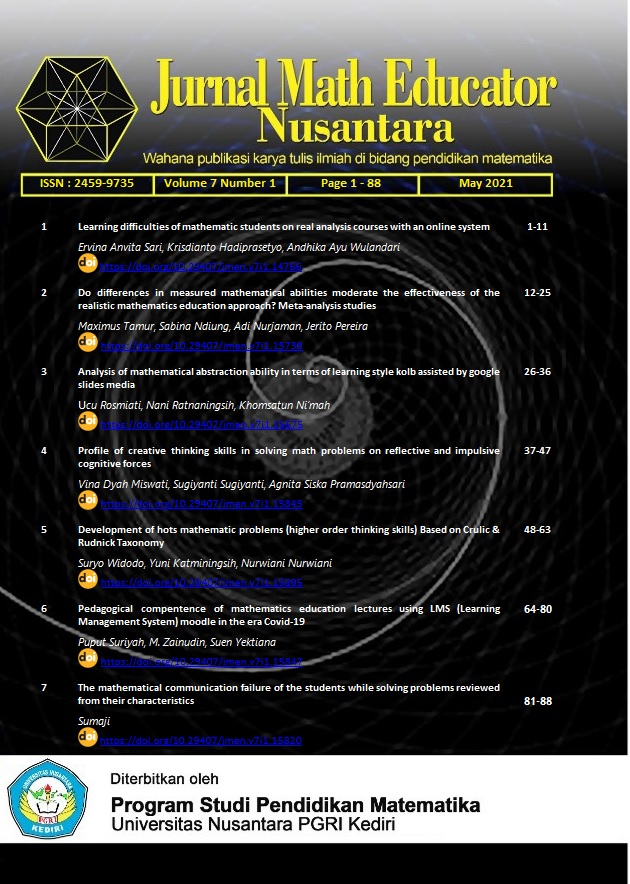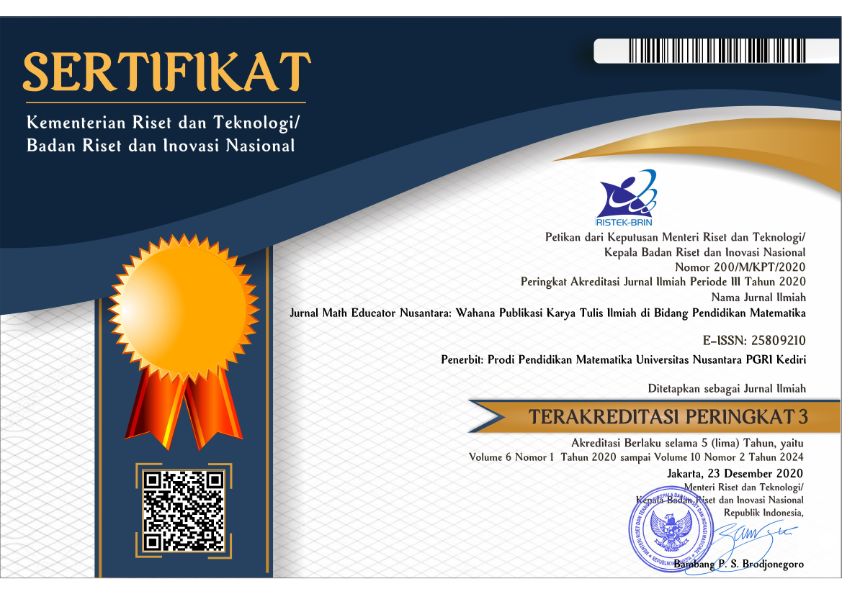The mathematical communication failure of the students while solving problems reviewed from their characteristics
DOI:
https://doi.org/10.29407/jmen.v7i1.15820Keywords:
Failures, Mathematics Communication, Rigorousness and freedomAbstract
Mathematics communication could develop conceptual understanding and mathematics problem-solving and reasoning. An excellent mathematics communication influences the problem-solving of learners. The mathematics communication skill characteristics are rigorousness, economy, and freedom. This research aimed to describe the learners’ mathematical communication failures in solving problems reviewed from the characteristics. This research is qualitative. There were 30 graders of VIII grade of Islamic JHS Maslakhul Huda, Sluke, Rembang. This research selected two learners that failed to communicate their problem-solving results based on the characteristics. The instruments to collect data were problem-solving tasks and interview guidelines. The findings showed that: (1) the learners that failed to communicate the problem-solving results only met the rigorousness and freedom characteristics, and (2) these learners only had rigorousness characteristics.
References
Cooke, B. D., & Buchholz, D. (2005). Mathematical Communication in the Classroom: A Teacher Makes a difference. Early Childhood Education Journal, 32(6), 365–369.
Depdiknas. 2013. Kamus Besar Bahasa Indonesia Pusat Bahasa.Cet. Kelima. Jakarta : PT Gramedia Pustaka Utama
ElSheikh, R. M., & Najdi, S. D. (2013). Math Keyboard Symbols and Its Effect in Improving Communication in Math Virtual Classes. International Journal of Information and Education Technology, 3(6), 638–642. https://doi.org/10.7763/IJIET.2013.V3.352
Inprasitha, P., Pattanajak, A., & Inprasitha, N. (2012). A Study of Student’s Mathematical Communication in Teacher Professional Development. Journal of Modern Education Review, 2(1), 38–46.
Jung, H. Y., & Reifel, S. (2011). Promoting Children’s Communication: A Kindergarten Teacher’s Conception and Practice of Effective Mathematics Instruction. Publication Cover Journal Journal of Research in Childhood Education, 25(2), 194–210. https://doi.org/10.1080/02568543.2011.555496
Kaya, D., & Aidyn, H. (2014). Elementary Mathematics Teachers’ Perceptions and Lived Experiences on Mathematical Communication. Eurasia Journal of Mathematics, Science & Technology Education, 12(6), 1619–1629. https://doi.org/10.12973/eurasia.2014.1203a
Karl W. Kosko, 2010. Mathematical Communication and Its Relation to the Frequency of Manipulative Use. International Electronic Journal of Mathematics Education, 5(2): 79–90.
Kongthip, Y., Inprasitha, M., Pattanajak, A., & Inprasitha, N. (2012). Mathematical Communication by 5th Grade Students’ Gestures in Lesson Study and Open Approach Context. Psychology, 3(8), 632–637. http://dx.doi.org/10.4236/psych.2012.38097
Lomibao, L. S., Luna, C. A., & Namoco, R. A. (2016). The Influence of Mathematical Communication on Students Mathematics Performance and Anxiety. American Journal of Educational Research, 4(5), 378–382. https://doi.org/10.12691/education-4-5-3
Nurlia. (2015). Kemampuan Komunikasi Matematika dalam Pembelajaran MatematikaSebelum dan Setelah Penerapan Pendekatan Matematika Realistik. Jurnal Daya Matematis, 3(5), 328–366.
Polya, G. (1973). How to Solve It. Princeton University.
Vale, I. & Barbosa, A., 2017. The Importance of Seeing in Mathematics Communication. Journal of the European Teacher Education Network, 12: 49–63.
Viseu, F., & Olivera, I. B. (2012). Open-ended Tasks in the Promotion of Classroom Communication in Mathematics. International Electronic Journal of Elementary Education, 4(2), 287–300.
Wahyuningrum, S. (2014). Association of Mathematical Communication and Problem Solving Abilities. Implementation of MEAs Strategy in Junior High School, 17, 38–50.
Yuniara, R. (2016). Students’ Mathematical Communication Skills in Finding the Concept of Direct and Inverse Proportions through. Discovery. Proceedings of the 1st EEIC in Conjunction with the 2nd RGRS-CAPEU between Sultan Idris Education University and Syiah Kuala University, November 12-13, 2016, Banda Aceh, Indonesia, 375–379.
Yusra, D., & Saragih, S. (2016). The Profile of Communication Mathematics and Students Motivation by Joyful Learning-Based Learning Context Malay Culture. British Journal of Education, Society &Behavioural Science, 15(4), 1–16.
Downloads
Published
Issue
Section
License
Authors who publish with this journal agree to the following terms:
- Copyright on any article is retained by the author(s).
- The author grants the journal, the right of first publication with the work simultaneously licensed under a Creative Commons Attribution License that allows others to share the work with an acknowledgment of the work’s authorship and initial publication in this journal.
- Authors are able to enter into separate, additional contractual arrangements for the non-exclusive distribution of the journal’s published version of the work (e.g., post it to an institutional repository or publish it in a book), with an acknowledgment of its initial publication in this journal.
- Authors are permitted and encouraged to post their work online (e.g., in institutional repositories or on their website) prior to and during the submission process, as it can lead to productive exchanges, as well as earlier and greater citation of published work.
- The article and any associated published material is distributed under the Creative Commons Attribution-ShareAlike 4.0 International License
















